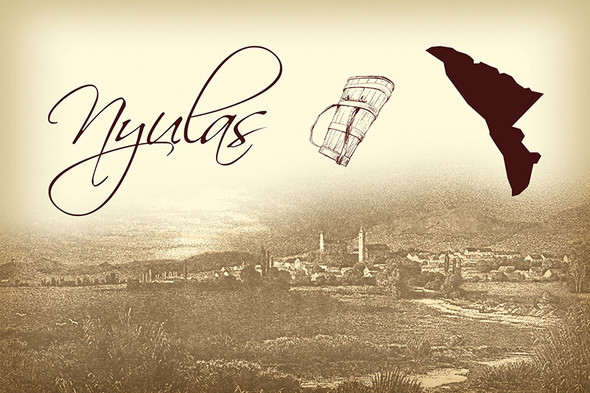The area was first mentioned in 1187 as the vineyard of the Johanniter Monastery in Tokaj Szentkereszt. Following the 1241 Mongol invasion of Hungary, Szentkereszt became a property of the parish and was later on taken over by the Paulite Monastery of Tokaj founded in 1386.
Written documents from the 15-18th centuries always designated Nyulas, with a few exceptions, as a vineyard of Tokaj or Tarcal. Its name, Nyulas meaning ‘full of rabbits’, derives from the fact that a lot of rabbits used to live in this area as early as the end of the Middle Ages when the vineyard was already called Nyulas. In the first half of the 15th century, the Hussites destroyed the Paulite Monastery of Tokaj which was rebuilt in 1470 by the most influential aristocrats of the Hegyalja region of that time, the Szapolyai family. Moreover, they even granted the Paulites of Tokaj special privileges between 1476 and 1520 such as the tax exemption for grapes and wine, i.e. they did not have to pay any tax on the grapes and wine produced.
Nyulas was first mentioned in 1476 in the written documents of that time as one of the most significant vineyards of the Paulites of Tokaj; in addition to the két Remete, Barát, Pincefeli, Csanga, Kuszár vineyards, Tanya and András Jakab vineyards. After the Battle of Mohács in 1526, the internal political conflict resulted in the Habsburg supporters destroying the Paulite Monastery of Tokaj backing the Szapolyai family; the monks were driven away and their lands seized by the Serédy family on the Habsburgs’ side. Their vineyards were also given to the above-mentioned family and attached to the castle-lordship of Tokaj. Despite the increasingly strengthening Reformed Church, the Serédy family supported Catholicism in the Hegyalja region and a part of the Nyulas Vineyard was donated to the Parish of Bodrogkeresztúr in the middle of the 16th century. At the same time, however, as the Reformed Church gained strength in the Hegyalja region, the parish vineyard became the property of the Protestant Parsonage of Bodrogkeresztúr in the 1540s. At the beginning of the 17th century this large vineyard was sold by the pastor to the noblemen of Zemplén County and this is how the blue-blood Gyulaffy, Sárossy, Szepessy and Szuhay families became its owners.
After 1557, new lords of Tokaj castle-lordship appeared: the Alaghy family supporting the Reformed Church. They also possessed the part of Nyulas Vineyard owned by the lordship, which was inherited jointly by György Rákóczi I (1593−1648), the Prince of Transylvania and his brother, Pál Rákóczi (1596−1636) who was Chief Justice, in 1635 from the Alaghy family. The inherited Nyulas Vineyard was divided between the two brothers and thus both sides owned large territories of Nyulas.
After György Rákóczi II (1621−1660), the Prince of Transylvania died, his widow Sophia Báthory (1629−1680) and her son Rákóczi Ferenc I (1645−1676) became Roman Catholics. On 6 January 1666 the portion of Nyulas owned by the Prince’s side (that is of György Rákóczi I and his offspring) was given to the Jesuit House and College of Uzhgorod as a pious donation and in support of the Roman Catholic Church. What is more, this donation was reinforced by the widow of the Prince of Transylvania in 1676. As far as we know, the Jesuits of Uzhgorod only harvested the grapes in the Nyulas Vineyard but neglected all other work and the condition of the land began to deteriorate. In 1680 the Viennese Court took the vineyard over from the monastery of Uzhgorod and transferred it to the Treasury. Only after this did the planting of the vines in this part of Nyulas start.
In 1670, after the unsuccessful Wesselényi Conspiracy against the Habsburgs, the Viennese Court seized the Nyulas Vineyards still owned by the Gyulaffy, Szuhay, Szepessy and Sárossy families for their participation in the plot. The confiscated properties were re-annexed to the Tokaj lordship, in other words, they were nationalized. At the same time, the vineyards possessed by the Rákóczi descendants on the other, on Pál’s side, were still owned by the family which died out in 1707 when Erzsébet Rákóczi passed away (1655−1707). The area was claimed by Ferenc Rákóczi II (1676−1735) Ruling Prince of Hungary, but after the Peace Agreement of Szatmár ending the Rákóczi Uprising in 1711, this part of the Nyulas was given over to the family of the late Erzsébet Rákóczi’s husband, Erdődy. The majority of the previously seized vineyards (i.e. the lands earlier owned by the Jesuits and noblemen) remained state property. Residents of Bodrogkeresztúr started to appear in Nyulas in the mid-18th century buying vineyards from the lordship. The smallholder structure appeared in Nyulas that time and existed until 1948 when nationalization began.






